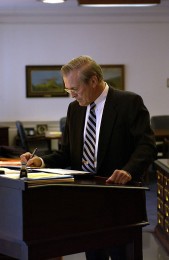Maybe You Should Have Written That at a Standing Desk

Standing desks: not just for tech bros, and not so new. For the Millions, Dominic Smith expounds on the “prestigious lineage” of writing that got done at the now-trendy standing desk.
There’s very little room to store abandoned manuscripts, rejection letters, or knickknacks. Distractions are kept to a minimum. It’s taller, sleeker, and less hospitable than its slouchier cousin. In the way that it mimics a lectern, a podium, or a drafting table, it reminds the writer that this activity requires blood, enzymes, and exertion. Here is your novel, spread out like a map or a campaign speech. Here are your poems, arranged like blueprints. Pace, stamp your feet, fold your arms, but stay upright. Stand there like it’s the prow of a ship.
Standing at the prow of a ship sounds great (she said from the comfort of her couch), but until I get a lectern of my own, I’m not going anywhere.
For further I should but I won’t guilt-spiration, Smith rounds up a list of famous writers who used standing desks:
Hemingway: “a set of bookshelves with a typewriter perched on top.”
Virginia Woolf: “a desk standing about three feet six inches high with a sloping top; it was so high that she had to stand at her work.”
Nabokov: “lovely old-fashioned lectern I have in my study.”
Philip Roth: swears he is done writing but when he did he did it standing up.
See also: Thomas Jefferson, Winston Churchill, Charles Dickens, Søren Kierkegaard. Damn you, people.
Photo via Wikimedia Commons
Support The Billfold
The Billfold continues to exist thanks to support from our readers. Help us continue to do our work by making a monthly pledge on Patreon or a one-time-only contribution through PayPal.
Comments